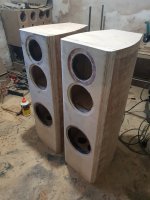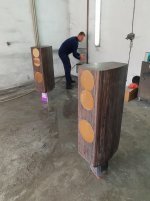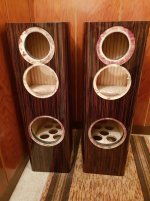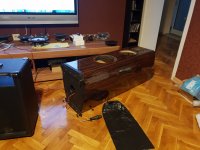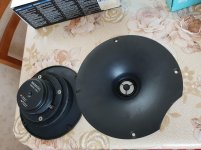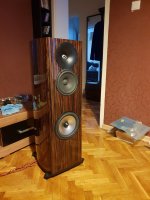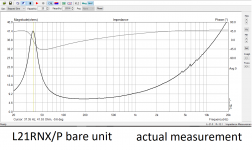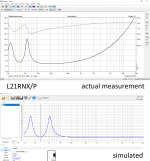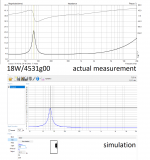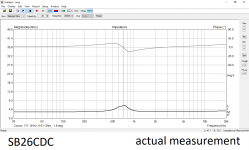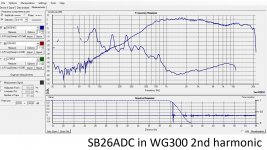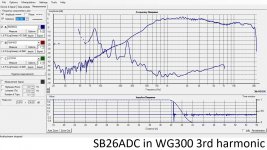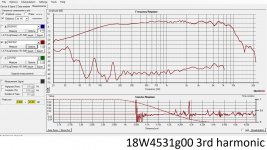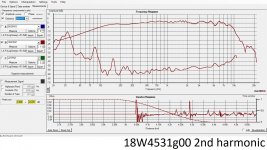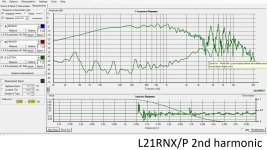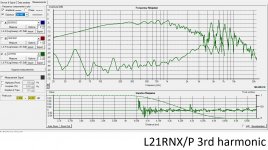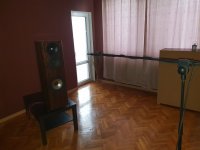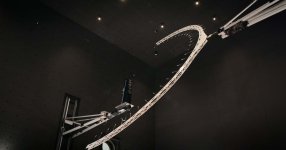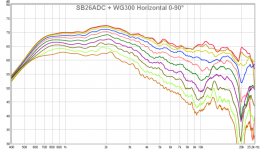Holidays came and I decided it was finally time to rework a pair of 2-way floorstanders that were sitting in my living room for over a decade by now. All parts were sitting on shelves for months but it was finally time.
These started many years ago as a 2-way based around the Scanspeak Revelator 18W woofer and the Vifa XT25TG ring radiator. I was unhappy with three aspects of the speaker:
- the Vifa totally lacked high end sparkle and required higher crossover which was an issue with the directivity of the 18W woofer
- to get somehow adequate bass the tuning was at 36Hz and total volume was 36l - but group delay was high up to 60Hz
- while bass was adequate for a single 18cm woofer, it is still far from what I would like
So, I decided to use the existinh boxes as they were solid enough and base the new speaker around them. The Vifa is in storage now and I took a few tweeters to experiment with:
- A Transducer labs N26CR2A - I bought a pair off ebay from a guy in Belgium but despite his claims, they were ruined when they arrived so I bought a new pair at the liquidation prices that were available back then. Excellent tweeter with superb detail, lacking any audible breakup nodes and higher distortion in the 8-10Khz range but its flange, god, the only way to mount a waveguide was to chamfer the holes of the screw assembly and I think that would put the driver at high risk of damage. Went on ebay...
-The SB26STCN is an exellent tweeter and I have several pairs of them, tried them but they somehow don`t work well in a waveguide. I think they`re too concave.
- Bought a pair of the new ceramic SB26CDC tweeters - they have all that is required to work well in a waveguide and the motor is excellent. I listened to them for 5 min today mounted in a 17cm shallow waveguide at very low power and have mixed feelings - they sounded soft without any serious breakup caused distortion (compared to the ADC aluminium version which is more aggressive to my ears) but somehow I think they lack detail which may be caused by the low power and waveguide lift. I tested them directly connected to the amp today - will try at higher power tomorrow through a cap. What I liked is how clean they were - from first impression, they can do easily 1.8Khz in the waveguide with a simple 2nd order slope. I need to carry out further tests onto these to confirm if they`d be into the project or will look for another tweeter.
For bass duties I had a pair of Seas L21RNX/P sitting forever on the shelf and they appeared to fit the now smallish 45l enclosure better than the SB23NRX and the Scanspeak 22W (new glass-fibre units) so saved some cash here
Midrange would be the Scanspeak Revelator 18W/4531g00 which I had left from th previous speakers. Their cones appear to have gotten grey over the years. I decided to put them in a small 10l sealed enclosure where the front baffle and the bump in heir response would be over the same frequeny range so to equalize each other and provide a flatter inbox response. Qtc is a little on the high side - 0.82 projected value by WinISD in a 9l sealed enclosure but somehow this woofer doesn`t model properly and require more volume so a 10l plus some stuffing should do to hit the target of around 0.82-0.85.
These started many years ago as a 2-way based around the Scanspeak Revelator 18W woofer and the Vifa XT25TG ring radiator. I was unhappy with three aspects of the speaker:
- the Vifa totally lacked high end sparkle and required higher crossover which was an issue with the directivity of the 18W woofer
- to get somehow adequate bass the tuning was at 36Hz and total volume was 36l - but group delay was high up to 60Hz
- while bass was adequate for a single 18cm woofer, it is still far from what I would like
So, I decided to use the existinh boxes as they were solid enough and base the new speaker around them. The Vifa is in storage now and I took a few tweeters to experiment with:
- A Transducer labs N26CR2A - I bought a pair off ebay from a guy in Belgium but despite his claims, they were ruined when they arrived so I bought a new pair at the liquidation prices that were available back then. Excellent tweeter with superb detail, lacking any audible breakup nodes and higher distortion in the 8-10Khz range but its flange, god, the only way to mount a waveguide was to chamfer the holes of the screw assembly and I think that would put the driver at high risk of damage. Went on ebay...
-The SB26STCN is an exellent tweeter and I have several pairs of them, tried them but they somehow don`t work well in a waveguide. I think they`re too concave.
- Bought a pair of the new ceramic SB26CDC tweeters - they have all that is required to work well in a waveguide and the motor is excellent. I listened to them for 5 min today mounted in a 17cm shallow waveguide at very low power and have mixed feelings - they sounded soft without any serious breakup caused distortion (compared to the ADC aluminium version which is more aggressive to my ears) but somehow I think they lack detail which may be caused by the low power and waveguide lift. I tested them directly connected to the amp today - will try at higher power tomorrow through a cap. What I liked is how clean they were - from first impression, they can do easily 1.8Khz in the waveguide with a simple 2nd order slope. I need to carry out further tests onto these to confirm if they`d be into the project or will look for another tweeter.
For bass duties I had a pair of Seas L21RNX/P sitting forever on the shelf and they appeared to fit the now smallish 45l enclosure better than the SB23NRX and the Scanspeak 22W (new glass-fibre units) so saved some cash here
Midrange would be the Scanspeak Revelator 18W/4531g00 which I had left from th previous speakers. Their cones appear to have gotten grey over the years. I decided to put them in a small 10l sealed enclosure where the front baffle and the bump in heir response would be over the same frequeny range so to equalize each other and provide a flatter inbox response. Qtc is a little on the high side - 0.82 projected value by WinISD in a 9l sealed enclosure but somehow this woofer doesn`t model properly and require more volume so a 10l plus some stuffing should do to hit the target of around 0.82-0.85.
Last edited:
So, I set off to work. I decided on a simpler flat baffle, compared to the slanted stepped baffle the 2-way used. It is a 48mm thick birch plywood baffle sized 90x25cm with 1" roundovers to the sides. The Freud bit that can do this costs an arm and a leg but does a really wonderful job. The large roundovers and the waveguide should make crossover work an easy job.
Inside the midrange chamber I built a hard wood diffuser to help scatter the backwave. The rest of the construction features curved 38mm sides made out of MDF and plywood bonded together and features extra bracing. Tops and bottoms are 38mm both and port will be downfacing. I set on a 45l vented enclosure for the Seas L21rnx/p bass unit with tunning of 28Hz. That should produce a -6db at 28Hz - more than adequate for a standard living room with group delay remaining under 10ms at 40Hz and under 6ms at 50Hz.
Inside the midrange chamber I built a hard wood diffuser to help scatter the backwave. The rest of the construction features curved 38mm sides made out of MDF and plywood bonded together and features extra bracing. Tops and bottoms are 38mm both and port will be downfacing. I set on a 45l vented enclosure for the Seas L21rnx/p bass unit with tunning of 28Hz. That should produce a -6db at 28Hz - more than adequate for a standard living room with group delay remaining under 10ms at 40Hz and under 6ms at 50Hz.
Attachments
I then prepared base with the stands that would put the speakers on spikes. As port for this tunning was long, I decided to lift the speakers on spikes, put the port downfiring and extend it this way - this will actas a flare and will provide a few more cm while the midrange shout would go to the floor and speaker could be placed somewhat closer to a wall.
The waveguides were trimmed for a closer fit to the woofers and a nicer look of course and a plywood backpanel was added to accept the SB26CDC tweeter. The plastic faceplate of this tweeter is a bit of a nightmare as it won`t seal properly and I had no gaskets like those supplied with the Monacor DT-300 tweeter so had to workout a gasket but some drywall soundproofing tape did the job. The WG300 is a cool waveguide but feels very flimsy so I filled it with silicone.
The waveguides were trimmed for a closer fit to the woofers and a nicer look of course and a plywood backpanel was added to accept the SB26CDC tweeter. The plastic faceplate of this tweeter is a bit of a nightmare as it won`t seal properly and I had no gaskets like those supplied with the Monacor DT-300 tweeter so had to workout a gasket but some drywall soundproofing tape did the job. The WG300 is a cool waveguide but feels very flimsy so I filled it with silicone.
Attachments
Last edited:
Today I finally managed to mount all drivers in place. To keep the screwheads vertical, I used a 90 degree drill guide and with a small 1mm bit prepared the screw holes so they can lead teh screws absolutely vertical. The bottom chamber for the Seas L21 was stuffed with polyfill, the upper midrange chamber - with Visaton wool. No leaks between the two chambers so good to go with measurements tomorrow.
I will probably start measuring and fine tunning tomorrow or Friday as I may need to go to work tomorrow. Bass measurements will be a challenge as the best I`ve been able to do inhouse was down to 280Hz but if weather is ok, may be lucky
I will probably start measuring and fine tunning tomorrow or Friday as I may need to go to work tomorrow. Bass measurements will be a challenge as the best I`ve been able to do inhouse was down to 280Hz but if weather is ok, may be lucky
Attachments
A bit out of schedule as I was supposed to do these on the 27th-28th. The audio interface I use (Komplete Audio 6) has an issue with USB 3 ports and until I figure out its the port, had to lose time and investigate. Pity as its a solid interface.
I ran impedance sweeps of the drivers in the box. The Scanspeak 18W/4531 is right where I want it to be (simulated response) and as a bare unit has not changed spec by 2% after so many years (over 10). I cannot say the same for the Seas. Its a 9 year old unit (since purchase as new) and is already way out of spec. Seas claimed Fs is put at 28Hz. I measured this one at 37.4Hz - 33.6% out of spec. Not nice. I suspect the Qts has gone up too and will estimate it using the closed box method tomorrow. All this resulted in actual box tuning at 38Hz. Will confirm this when I measure with the mic. Friend warned me about Seas driver units` tendency to stiffen their rubber suspension in a matter of years changing parameters and I can see why.
I will have to either live with them as they are or reroute the enclosure and go for a pair of SB23NRXS which will work fine.
I ran impedance sweeps of the drivers in the box. The Scanspeak 18W/4531 is right where I want it to be (simulated response) and as a bare unit has not changed spec by 2% after so many years (over 10). I cannot say the same for the Seas. Its a 9 year old unit (since purchase as new) and is already way out of spec. Seas claimed Fs is put at 28Hz. I measured this one at 37.4Hz - 33.6% out of spec. Not nice. I suspect the Qts has gone up too and will estimate it using the closed box method tomorrow. All this resulted in actual box tuning at 38Hz. Will confirm this when I measure with the mic. Friend warned me about Seas driver units` tendency to stiffen their rubber suspension in a matter of years changing parameters and I can see why.
I will have to either live with them as they are or reroute the enclosure and go for a pair of SB23NRXS which will work fine.
Attachments
I then prepared base with the stands that would put the speakers on spikes. As port for this tunning was long, I decided to lift the speakers on spikes, put the port downfiring and extend it this way - this will actas a flare and will provide a few more cm while the midrange shout would go to the floor and speaker could be placed somewhat closer to a wall.
The waveguides were trimmed for a closer fit to the woofers and a nicer look of course and a plywood backpanel was added to accept the SB26CDC tweeter. The plastic faceplate of this tweeter is a bit of a nightmare as it won`t seal properly and I had no gaskets like those supplied with the Monacor DT-300 tweeter so had to workout a gasket but some drywall soundproofing tape did the job. The WG300 is a cool waveguide but feels very flimsy so I filled it with silicone.
Congratulations for the work, very nice.
Just one comment, you say that housing the tweeter in the waveguide has been a nightmare. Is it aligned in time with respect to the midrange? It would seem that the dome of the tweeter is far back, maybe you could try some other form of assembly to bring it closer to the front.
Time-Alignment
Greetings and Happy New Year
They`re supposed to be time aligned, yes. I have used the WG300 waveguide many times and at least with the XT25 ring radiator and the DT-300 tweeter from Monacor they align about perfect with the 18W. I do not know where the exact acoustic centre of the SB26CDC is so until I measure them with a mic, I can`t yet tell. The WG300 looks quite deep but it isn`t, indeed, I think it is 34mm.
Happy new year to all!
Happy new year to all!
They`re supposed to be time aligned, yes. I have used the WG300 waveguide many times and at least with the XT25 ring radiator and the DT-300 tweeter from Monacor they align about perfect with the 18W. I do not know where the exact acoustic centre of the SB26CDC is so until I measure them with a mic, I can`t yet tell. The WG300 looks quite deep but it isn`t, indeed, I think it is 34mm.
Happy new year to all!
Thank you for your wishes, they are appreciated !
Loudspeaker time alignment - Wikipedia
the acoustic center of each speaker is explained in the attached link of Wikipedia
But leave it for next year !
PS: Here are nine hours left for the lack of control ....
Last edited:
Finally got some time to continue. I took measurements yesterday - with my new Komplete Audio 6 audio interface and new computer and immediately run into a problem with Holm Impulse (not present with Arta). The impulse response is not at zero but is plotted further away. I guess some latency issue as on Arta it looks normal (besides this shift, all else matches perfectly.
I had to lower the port tuning of the L21rnx/p woofer and is now at 34Hz which should be fine, considering its Qts has gone up (I measured 0.42 making it better suitable for a sealed box but I know such Qts will work fine with port tuning below Fs as in this case).
These were measured at a distance of 0.75m with mic at tweeter level and the speaker was raised on a tiny table in a totally emptied room (I even removed the ceiling lamp). Due to the impulse response issue, Holm is not showing me the gating but according to Arta, a these settings I`m good from 150Hz upwards. Mic cable was wrapped around the stand and mic was on the stand mounting axis to reduce stand reflections. This is run through a Komplete Audio 6 interface and a Beyerdynamic MM1 mic which was additionally calibrated in Koln, Germany.
The SB Acoustics SB26CDC (says ADC on the photo by mistake) tweeter in the waveguide, phase shield not removed, gated at 150Hz:
I had to lower the port tuning of the L21rnx/p woofer and is now at 34Hz which should be fine, considering its Qts has gone up (I measured 0.42 making it better suitable for a sealed box but I know such Qts will work fine with port tuning below Fs as in this case).
These were measured at a distance of 0.75m with mic at tweeter level and the speaker was raised on a tiny table in a totally emptied room (I even removed the ceiling lamp). Due to the impulse response issue, Holm is not showing me the gating but according to Arta, a these settings I`m good from 150Hz upwards. Mic cable was wrapped around the stand and mic was on the stand mounting axis to reduce stand reflections. This is run through a Komplete Audio 6 interface and a Beyerdynamic MM1 mic which was additionally calibrated in Koln, Germany.
The SB Acoustics SB26CDC (says ADC on the photo by mistake) tweeter in the waveguide, phase shield not removed, gated at 150Hz:
Attachments
Last edited:
The 18W/4531g00 midwoofer (used as an asymmetrically extended midrange). I`ve seen measurements of that woofer (not sure which version it was) and it did exhibit large 2nd order peak at 450-700Hz, which I do not see here. These units are very well broken in, they`ve been in daily use for over 10 years.
Attachments
I am definitely getting some reflections off that table I use to put the speaker on so will have to workout some solution or make a special stand and remeasure. I think we should have some good weather in a week or so so outdoors would be ideal as I`m not entirely happy with these sets of measurements.
Measurement room:
Measurement room:
Attachments
...as I`m not entirely happy with these sets of measurements.
Yes, I think I know what you mean by that. Anyone up to clone a Jupiter system?
An array of 31 mics to record the response from 0-180 deg in a single go. Need I say that the loudspeaker base rotates at will and the array as well, so I figure.
Attachments
Last edited:
I do screenshots, hence the resolution, sorry. But I can remeasure - the impedance plot has hickups at the resonances - three in total, although I see more on the frequency response graph. If interested (in the SB26CDC predominantly) I can do +/- 45 degree in steps of 5 degrees (I will do these but on the final speaker only, planned crossover is 300Hz and 1.9Khz so not expecting any significant off-axis dropouts).
I wish I had the room and equipment these guys show But, here it is easy to rent for cheap a concert hall, I think it will make a great measurement environment. When you tell them what you wanna do, most of the time I get free offers to use it
But, here it is easy to rent for cheap a concert hall, I think it will make a great measurement environment. When you tell them what you wanna do, most of the time I get free offers to use it 
By the way, the SB26SCDC seems to work great with a waveguide. There is some wiggling above 12Khz but doing sweeps recently showed me I can hear to 15Khz...
I wish I had the room and equipment these guys show
By the way, the SB26SCDC seems to work great with a waveguide. There is some wiggling above 12Khz but doing sweeps recently showed me I can hear to 15Khz...
Mario, I tried SB26ADC + WG300. I used same mounting. Looking at your measured axial response, it looks almost identical to what I measured. My measurement was done in 2way baffle 420x220. I am curious to see your furher measurements and listening impessions.
Attachments
I'm certain that L21 works like a piston but there seems to be something at 310Hz, guessing standing wave.
When I measured it bare (so no enclosure) - see the first page, last impedance plot - to check for T/S inconsistency which I noted when in the box (and later using a 10l box it appeared to have a Qts of 0.42, about 20% higher than the reported) - it did have a bump at 310hz. Not a standing wave. I believe this is suspension related issue.
I`m still not sure why the impulse response starts with such delay, have to check up the latency of the new audio interface.
Last edited:
- Status
- This old topic is closed. If you want to reopen this topic, contact a moderator using the "Report Post" button.
- Home
- Loudspeakers
- Multi-Way
- Turning a 2-way into a 3-way
